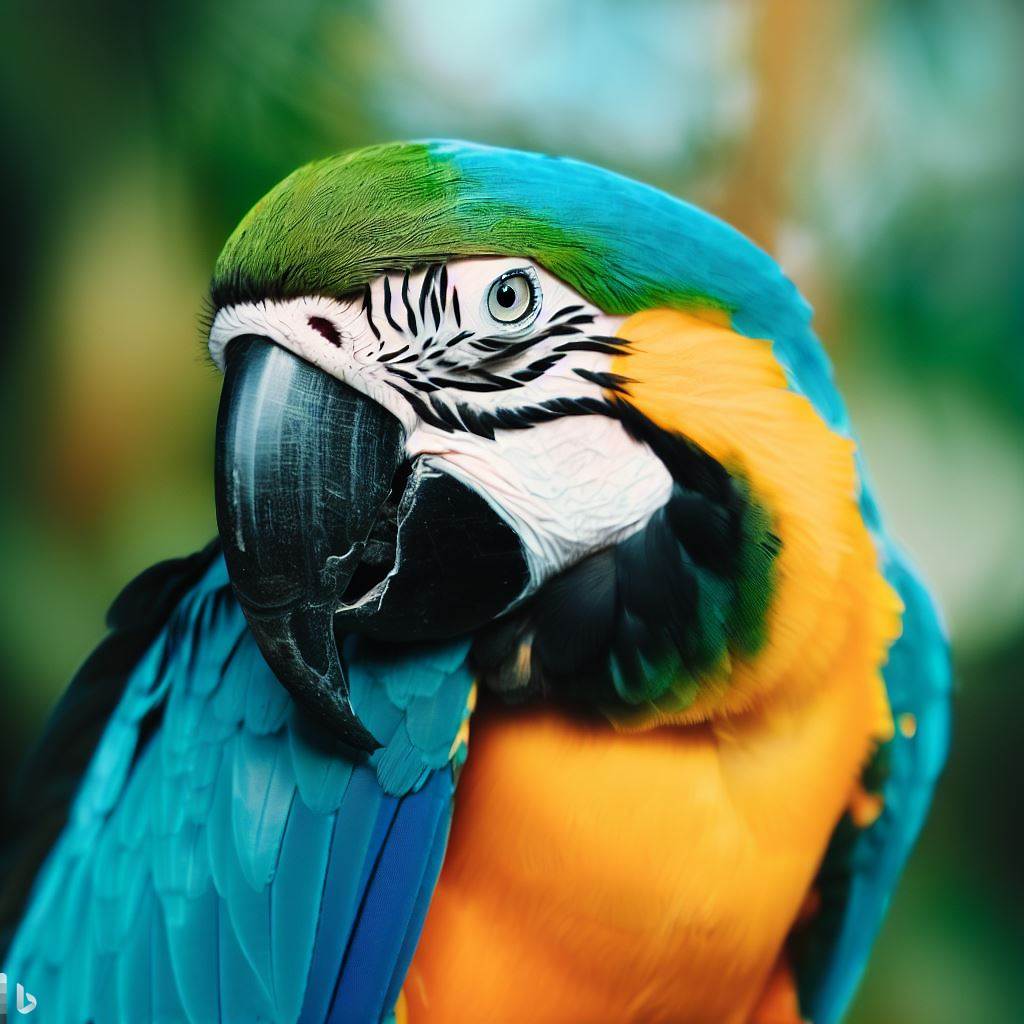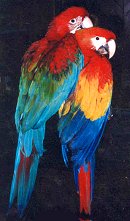
The Internet is a wonderful place to do your research. There are many good articles about Macaws on the web. Two of the very best websites are BirdsnWays.com and UpAtSix.com. Both have areas where you can ask and receive good advice on the species you are most interested in. Please take the time to do your homework before you go bird shopping, you’ll be glad you did!
Okay now that you’ve narrowed it down to (hopefully) a few species, the search is on! Where do you look? Try a pet shop, breeder, private owner, rescue organization, or zoo. Also Humane Societies, as well as your local Animal Control Offices are sources. And best of all your local bird clubs are all wonderful places to check. Do not overlook magazines or newspapers. There are many good reputable breeders around and a good way to locate breeders in your area is in the local newspaper or on the web. Birds n Ways, Up At Six, the Aviary, and the Avian Network have search engines to locate birds and breeders.
While you are at it, check for names of good local avian vets or a vet that sees quite a few birds. Write down the name and phone number. If you have a name that keeps popping up chances are it’s a good choice. Have an avian vet and have a backup vet. Most accidents happen either on the weekend or on the holidays. If your vet is not available, you need someone else to contact. A good vet can become your best friend!
Next, visit some pet shops that look clean, where the information is good, and where you are able to learn as well as look. What are you looking for, a bird you say? Well perhaps not just yet. First lets do a little more homework. Prepare for yourself a little mental checklist to run through so you have a good idea of what you are seeing when you look at a bird. Careful observation is the key. Have a list of questions to ask and do not be afraid to ask them. If the answers are short or non-existent, thank them for their time and move on to the next shop. If a pet shop or breeder does not have the time to answer your questions, most likely they will not to be available when you have problems either.
Many breeders will gladly answer your questions, they will be available to help and guide you, but not all are willing to allow you to visit their homes/aviary. Many breeders now practice the closed aviary concept. No new birds are allowed into the aviary unless stringent quarantine methods are practiced. The reason they do not allow visitors is to limit foot traffic that can bring harm or disease to the birds/aviary. Many times the guarantee on closed aviary birds is much better than you will find at other places because the risk of disease has been drastically minimized. How you will view the birds available is up to the breeder.
Health of the bird should be the number one consideration. Check out the environment in which the bird is being kept. Check to make sure it is clean; that water and food dishes are available. What is in the cage besides the bird? Does the cage contain toys? Mineral block? Perches? Is the bird being offered fresh foods? Take a look at the bottom of the cage at the paper and check the consistency of the poop, but more about that later. Right now you want to see what you can learn from just looking and watching.
How is the bird standing, is it using both feet? Look the toes over. Are the nails trimmed, do they need trimming, are they all there? Does the bird look able to entertain itself or does it seem to be bored and not interested in its surroundings. What happens when you make eye contact, do the bird’s eyes follow you or are you ignored? A listless bird may be an indication of a bird that is not feeling well.
What do you look for? Look for a bird that has bright eyes, personality, and one that is able to entertain itself in play. These birds are less likely to become screamers due to insecurity. A confident bird will be better equipped to entertain itself when you are not available, as well as interact with you and your family.
How to determine a birds age
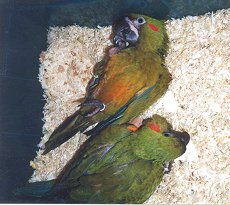
If it is a baby bird, is it completely weaned? Never buy an unweaned bird if you have no experience with hand feeding. The old wive’s tale that a baby bird will bond better with the person who hand feeds it is just that – an old wive’s tale.
The fastest way to help distinguish a bird under the age of 1 year is to check the eyes, beak and feet.
The things that jump out and indicate it’s a young bird, rather than an older one, are first the eyes, the dewy, soft look of the overall bird.
In a young bird the ring around the eye will be brown, not a light gray, which in the Blue and Gold’s is an indication of a bird over a few years of age. Dark eyes, young bird.
The bill, when felt, will have a softer feel to it. The color will be darker and deeper. Babies have a smooth, shorter beak, while most older ones have a longer hook and may also have some normal sloughing.
The feet will be a darker black than in the older birds. If they are a lighter grey and scaley, then this is an indication of an older bird. In a younger bird, the feet will usually be smooth and supple, without the thick callouses which result from perching. The nails are not yet very long.
Also look at the tail feathers. Young macaws will often have very ratty looking feathers, especially the tail feathers, as they are somewhat clumsy. Caring for that long tail is something that has to be learned.
One trait that is common in handfed youngsters is that they will bob their heads up and down. This is a feeding behavior and not a phobic problem.
It may also offer a small little squeak. Further, a younger bird will normally not be as quick to strike out if a stranger approaches.
Take note of the environment in which the bird is being kept.
Enter the area where the birds are housed and note cleanliness and equipment and the condition of the other birds in that area. Avoid any places, breeders or vendors where the cages are not clean, where there are dirty food and water dishes, where there is caked poop on the feet or where the birds seem lethargic or puffed up, are resting on the floor of the cages or seem ill.
Ask for a health guarantee. If the vendor won’t give you one, then find a place that will. Most breeders stand behind and guarantee their chicks. Don’t settle for less!
Evaluate the bird for its health, personality and reaction to you.
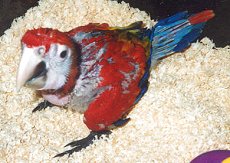
Next walk up to the bird to observe the health of the bird and how this bird reacts to you. Without making a move, look at the feet first. If the bird is friendly, then feel the feet. They should be smooth. If it steps up on your arm, the grip should be firm and strong. At this time you can feel if each of the toes are being used, and if they have a firm and even grab. If one does not, then you may want to take a closer look and see why. Perhaps it is just position, but perhaps not.
Next look into the eyes. They should be bright, shiny and the pupil normal. The eyes should not have a cloudy look to them, which would or could be an indication of cataracts. In much older birds it can even appear white or like fog. There should be no discharge, nor should the feathers beneath the eyes be damp or wet.
Check the vent, making sure that it clean. The vent should be dry, no discharge, nor signs of diarrhea either on the bird or on the cage floor. Take a good look at the droppings. They shouldn’t be runny nor should they show constipation. If they do seem a little runny, check the diet to see if they are on a pelleted diet. If so it MAY account for the runny looking poop, as birds will consume more liquids because the dry pellets make them thirsty. If however the bird is on a seed/fresh foods/pellet diet check the poop to make sure the food is being digested and does not contain whole seed or food. Check the color of the poop.
Next take a look at the breathing, which should be even, easy, but quiet while the bird is at rest. Labored breathing is a sign of illness. You may want to check the birds breathing after exercise, or have someone else more familiar with the bird hold the bird and make it flap to see how it breathes after exercise. The bird should not be frightened, but if the bird is raised up then lowered, most likely the bird will flap. The respiration rate may quicken, but it should quickly return to normal. Listen for any wheezing sounds.
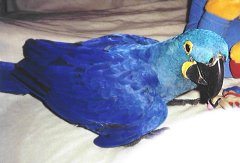
The breastbone shouldn’t protrude sharply; ideally the breast area is rounded and full. You also want to pull a few feathers back and look at the skin. A yellow cast is an indication of excess fat. If the bird is on the fat side you will want to make some changes to the diet.
Check the feathers. Feathers can reflect diet or environment. A healthy bird will have shiny feathers and be free of dirt or a dusty looking appearance. The feather shafts will be normal, not thin or weak looking. Disregard broken tail feathers in young birds as many macaws will not learn to appreciate that long thing that gets in its way. It is seen as a nuisance, thus it’s normal for a young bird with a long tail to break its baby feathers. It may take a couple of years before it becomes a thing of pride.
If the tail feathers resemble a bottlebrush also overlook this as it is an indication of an active bird that plays hard and the tail goes in and out of the bars of the cage. This can be seen in young or older birds. A little shower and smoothing and the tail will be back into shape again. The tail feathers should be there, even if they are broken. Feathers that are bent will straighten out using the same method. It can be an indication of a cage that is too small or that it has been in a smaller carrier or container.
Dull or discolored feathers indicate a poor diet. Black lines on the feathers indicate stress. Our vet once told me that he could tell by looking at the stress lines on a bird what kind breeder a person was. I laughed and said sure! On one particular visit he kept studying our bird over and over and nodding and saying hummm, uh huh, and I was growing more concerned by the minute. Finally I could stand it no more and blurted out “what was wrong with my bird, what did he find and what was he looking for”. The reply was “I am looking for a stress bar. Harrumph!” However, it did cause us to take a closer look and we could actually tell when the chick was pulled from the parent (stress bar), when or if the formula was changed (stress bar), the first vet visit, (stress bar). Yes, they can all show up. It is almost like a road map. I found this fascinating! Once it was pointed out to me, I learned that a bird of any age can and will still show signs of stress. In Hyacinth and other Macaws it may be a white feather, or if a medical problem odd coloration of the feathers may show up. Look for abnormal colorations. A good diet will overcome a lot of feather problems, but changes won’t be seen until the baby molts.
Remember a bird that is sick won’t let anyone know it is sick unless it is really sick.
Assess its attitude; is it alert, active, and interested in its surroundings?
The next move is to talk to the bird, see how it reacts to YOU. Does it respond to your talking to it? Do you feel drawn to it?
If everything checks out, then give it a try.
Last but not least DO get a good book. The Large Macaws by Joanne Abrahams is a little pricey but has a wealth of information.

